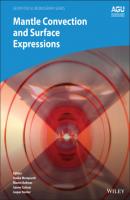Mantle Convection and Surface Expressions. Группа авторов
Чтение книги онлайн.

Читать онлайн книгу Mantle Convection and Surface Expressions - Группа авторов страница 66
Название: Mantle Convection and Surface Expressions
Автор: Группа авторов
Издательство: John Wiley & Sons Limited
Жанр: Физика
isbn: 9781119528593
isbn:
Several major mantle minerals go through continuous phase transitions at pressures and temperatures relevant to Earth’s lower mantle. Continuous phase transitions include ferroelastic phase transitions between polymorphs of calcium silicate perovskite (Shim et al., 2002; Stixrude et al., 2007) and between stishovite and CaCl2‐type SiO2 (Andrault et al., 1998; Carpenter et al., 2000; Karki et al., 1997b; Lakshtanov et al., 2007) as well as continuous changes in the electronic configurations of ferrous and ferric iron, i.e., spin transitions (Badro, 2014; Lin et al., 2013). Both ferroelastic phase transitions and spin transitions are associated with substantial softening of elastic moduli that is not commonly accounted for in mineral‐physical models. Anomalies in elastic properties that arise from ferroelastic phase transitions can be described in terms of excess properties using Landau theory (Carpenter and Salje, 1998) and integrated into finite‐strain formalisms (Buchen et al., 2018a; Tröster et al., 2014, 2002). To model elastic softening due to spin transitions, a similar approach can be adopted by formulating excess properties that arise from compression‐ and temperature‐induced changes in the distribution of d electrons of iron cations over multi‐electron states. Crystal‐field theory provides the basis for a semi‐empirical formalism that can be used to describe elastic anomalies associated with spin transitions of Fe2+ in ferropericlase and of Fe3+ in bridgmanite and in the CF phase at ambient temperature. In the absence of direct measurements of elastic softening at combined high pressures and high temperatures, predictions and extrapolations of elastic properties to realistic mantle temperatures based on Landau theory, crystal‐field theory, or DFT computations need to be made with caution.
Integrating elastic anomalies caused by continuous phase transitions into forward models for elastic properties of rocks in Earth’s lower mantle leads to discernible perturbations of P‐ and S‐wave velocities. While the broad spin transition of Fe2+ in ferropericlase reduces the computed P‐wave velocities of peridotitic rocks throughout the entire lower mantle, the spin transition of ferric iron in very Fe3+‐rich bridgmanite would mostly affect P‐wave velocities in the upper half of the lower mantle. In addition to their direct impact on P‐wave velocities, spin transitions are expected to alter the Fe‐Mg exchange between ferropericlase and bridgmanite (Badro, 2014; Xu et al., 2017) that appears to exert a strong leverage especially on S‐wave velocities. The potential compositional effect of spin transitions on seismic properties could have implications for the interpretations of large low‐velocity provinces (LLVP). A comparison of the overall seismic signature of peridotitic rocks with the preliminary reference Earth model (PREM; Dziewonski & Anderson, 1981) reveals trade‐offs between feasible interpretations in terms of the chemical and thermal structure of the lower mantle. Despite the low volume fraction of free silica phases found in experiments on basaltic bulk rock compositions, the softening of the shear modulus across the ferroelastic phase transition between stishovite and CaCl2‐type SiO2 might be strong enough to dominate elastic wave speeds of metabasaltic rocks in the lower mantle. The resulting low elastic wave speeds could give rise to scattering of seismic waves by fragments of recycled oceanic crust and contribute to low elastic wave speeds within LLVPs.
ACKNOWLEDGMENTS
The author would like to thank J. M. Jackson and W. Sturhahn for discussions about spin transitions and G. Steinle‐Neumann for providing valuable feedback on parts of the manuscript. The constructive feedback of three anonymous reviewers is highly appreciated and helped to improve the manuscript. National Science Foundation’s Collaborative Study of Earth’s Deep Interior (EAR‐1161046, awarded to J. M. Jackson) supported a portion of this work.
REFERENCES
1 Abramson, E.H., Brown, J.M., & Slutsky, L.J. (1999). Applications of impulsive stimulated scattering in the Earth and planetary sciences. Annu. Rev. Phys. Chem., 50, 279–313. https://doi.org/10.1146/annurev.physchem.50.1.279
2 Abu‐Eid, R.M., & Burns, R.G. (1976). The effect of pressure on the degree of covalency of the cation‐oxygen bond in minerals. Am. Mineral., 61, 391–397.
3 Andrault, D., Angel, R.J., Mosenfelder, J.L., & Bihan, T.L. (2003). Equation of state of stishovite to lower mantle pressures. Am. Mineral., 88, 301–307. https://doi.org/10.2138/am‐2003‐2‐307
4 Andrault, D., & Fiquet, G. (2001). Synchrotron radiation and laser heating in a diamond anvil cell. Rev. Sci. Instrum., 72, 1283–1288. https://doi.org/10.1063/1.1343866
5 Andrault, D., Fiquet, G., Guyot, F., & Hanfland, M. (1998). Pressure‐induced Landau‐type transition in stishovite. Science, 282, 720–724. https://doi.org/10.1126/science.282.5389.720
6 Andrault, D., Petitgirard, S., Lo Nigro, G., Devidal, J.‐L., Veronesi, G., Garbarino, G., & Mezouar, M. (2012). Solid–liquid iron partitioning in Earth’s deep mantle. Nature, 487, 354–357. https://doi.org/10.1038/nature11294
7 Angel, R.J. (2000). Equations of state. Rev. Mineral. Geochem., 41, 35–59. https://doi.org/10.2138/rmg.2000.41.2
8 Angel, R.J., Alvaro, M., & Gonzalez‐Platas, J. (2014). EosFit7c and a Fortran module (library) for equation of state calculations. Z. Kristallogr. – Cryst. Mater., 229, 405–419. https://doi.org/10.1515/zkri‐2013‐1711
9 Angel, R.J., Downs, R.T., & Finger, L.W. (2000). High‐temperature–high‐pressure diffractometry. Rev. Mineral. Geochem., 41, 559–597. https://doi.org/10.2138/rmg.2000.41.16
10 Angel, R.J., Jackson, J.M., Reichmann, H.J., & Speziale, S. (2009). Elasticity measurements on minerals: a review. Eur. J. Mineral., 21, 525–550. https://doi.org/10.1127/0935‐1221/2009/0021‐1925
11 Anisimov, V.I., Aryasetiawan, F., & Lichtenstein, A.I. (1997). First‐principles calculations of the electronic structure and spectra of strongly correlated systems: the LDA + U method. J. Phys: Condens. Matter, 9, 767–808. https://doi.org/10.1088/0953‐8984/9/4/002
12 Anisimov, V.I., Zaanen, J., & Andersen, O.K. (1991). Band theory and Mott insulators: Hubbard U instead of Stoner I. Phys. Rev. B, 44, 943–954. https://doi.org/10.1103/PhysRevB.44.943
13 Antonangeli, D., Komabayashi, T., Occelli, F., Borissenko, E., Walters, A.C., Fiquet, G., & Fei, Y. (2012). Simultaneous sound velocity and density measurements of hcp iron up to 93 GPa and 1100 K: An experimental test of the Birch’s law at high temperature. Earth Planet. Sci. Lett., 331–332, 210–214. https://doi.org/10.1016/j.epsl.2012.03.024
14 Antonangeli, D., Siebert, J., Aracne, C.M., Farber, D.L., Bosak, A., Hoesch, M., et al. (2011). Spin crossover in ferropericlase at high pressure: a seismologically transparent transition? Science, СКАЧАТЬ